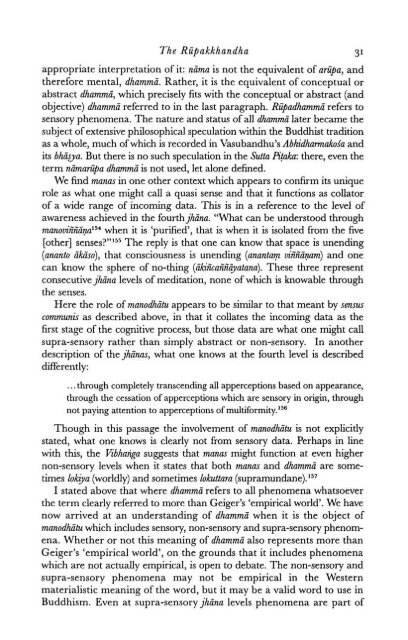Identity and Experience_Hamilton_1996
Identity and Experience_Hamilton_1996
Identity and Experience_Hamilton_1996
Create successful ePaper yourself
Turn your PDF publications into a flip-book with our unique Google optimized e-Paper software.
The Ripakkh<strong>and</strong>ha<br />
appropriate interpretation of it: nima is not the equivalent of arqa, <strong>and</strong><br />
therefore mental, dhammi. Rather, it is the equivalent of conceptual or<br />
abstract dhammi, which precisely fits with the conceptual or abstract (<strong>and</strong><br />
objective) dhammi referred to in the last paragraph. Riipadhammi refers to<br />
sensory phenomena. The nature <strong>and</strong> status of all dhammii later became the<br />
subject of extensive philosophical speculation within the Buddhist tradition<br />
as a whole, much of which is recorded in Vasub<strong>and</strong>hu's Abhidhamzakoia <strong>and</strong><br />
its bhiga. But there is no such speculation in the Sutta Pitaka: there, even the<br />
term nimarzipa dhammi is not used, let alone defined.<br />
We find manas in one other context which appears to confirm its unique<br />
role as what one might call a quasi sense <strong>and</strong> that it functions as collator<br />
of a wide range of incoming data. This is in a reference to the level of<br />
awareness achieved in the fourthjhina. "What can be understood through<br />
mano~in"n"inal~~ when it is 'purified', that is when it is isolated from the five<br />
[other] senses?"155 The reply is that one can know that space is unending<br />
(ananto ikso), that consciousness is unending (anantam viiiiiigam) <strong>and</strong> one<br />
can know the sphere of no-thing (ikn"can"n"123)atana). These three represent<br />
consecutive jhina levels of meditation, none of which is knowable through<br />
the senses.<br />
Here the role of manodhitu appears to be similar to that meant by sensus<br />
communi.r as described above, in that it collates the incoming data as the<br />
first stage of the cognitive process, but those data are what one might call<br />
supra-sensory rather than simply abstract or non-sensory. In another<br />
description of the jhinas, what one knows at the fourth level is described<br />
differently:<br />
. . . through completely transcending all apperceptions based on appearance,<br />
through the cessation of apperceptions which are sensory in origin, through<br />
not paying attention to apperceptions of rn~1tiforrnity.l~~<br />
Though in this passage the involvement of manodhitu is not explicitly<br />
stated, what one knows is clearly not from sensory data. Perhaps in line<br />
with this, the Vibhariga suggests that manas might function at even higher<br />
non-sensory levels when it states that both manm <strong>and</strong> dhammi are sometimes<br />
lokya (worldly) <strong>and</strong> sometimes lokuttara (supramundane). 15'<br />
I stated above that where dhammi refers to all phenomena whatsoever<br />
the term clearly referred to more than Geiger's 'empirical world'. We have<br />
now arrived at an underst<strong>and</strong>ing of dhammi when it is the object of<br />
manodhitu which includes sensory, non-sensory <strong>and</strong> supra-sensory phenomena.<br />
Whether or not this meaning of dhammi also represents more than<br />
Geiger's 'empirical world', on the grounds that it includes phenomena<br />
which are not actually empirical, is open to debate. The non-sensory <strong>and</strong><br />
supra-sensory phenomena may not be empirical in the Western<br />
materialistic meaning of the word, but it may be a valid word to use in<br />
Buddhism. Even at supra-sensory jhiina levels phenomena are part of<br />
3 I


